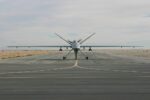At DSEI 2025 in London, U.S.-based drone manufacturer Skydio unveiled its latest autonomous deployment solution—the Skydio Dock for the X10 UAV. This ruggedized docking station enables fully automated launch, recovery, and recharging of the company’s flagship enterprise drone platform. Designed to support continuous aerial monitoring missions without human intervention, the system is aimed at enhancing situational awareness for critical infrastructure protection and public safety agencies.
Skydio Dock Overview: Persistent Autonomy in a Box
The Skydio Dock is a weather-resistant ground station that houses and services the Skydio X10—a compact quadcopter equipped with advanced AI-driven navigation and multispectral sensing capabilities. The dock enables truly unattended operations by handling automated takeoff/landing cycles and wireless charging between sorties. This makes it ideal for persistent ISR (intelligence, surveillance, reconnaissance) tasks such as perimeter security at power plants or airports, or rapid response to emergencies in urban environments.
Key features of the Skydio Dock include:
- All-weather enclosure: IP-rated protection against dust and precipitation
- Autonomous charging: Wireless high-speed charging pad inside dock
- Remote operations: Supports BVLOS (Beyond Visual Line of Sight) flights under FAA waivers or remote pilot supervision
- AI integration: Works with Skydio’s onboard computer vision stack to detect anomalies or track objects autonomously
The dock is designed to be deployed permanently or temporarily on rooftops or ground installations. With LTE/5G connectivity and cloud integration via Skydio Remote Ops software suite (formerly “Skydio Cloud”), operators can schedule patrols or respond to alerts from anywhere.
X10 Drone Capabilities: AI-Powered ISR Platform
The Skydio X10—launched in late 2023—is a modular UAV platform optimized for both tactical ISR missions and industrial inspection. It features a carbon-composite airframe with folding arms for portability and integrates multiple sensor payloads including EO/IR cameras and LiDAR modules.
The standard payload includes:
- 50MP RGB camera with up to 8x zoom
- Thermal imaging module: FLIR Boson+ with radiometric output
- NVIDIA Jetson Orin SoC: Onboard AI processing for real-time object detection/classification
This allows the X10 to autonomously map environments, identify vehicles/personnel of interest using computer vision models trained on specific datasets (e.g., uniforms or license plates), and relay actionable data back to command centers in near real-time. The drone’s autonomy stack enables obstacle avoidance even in GPS-denied environments using visual SLAM (Simultaneous Localization And Mapping).
Applications Across Public Safety and Critical Infrastructure
The combined solution of the X10 + Dock is already being piloted by several U.S. police departments under FAA Part 107 waivers that allow remote operation beyond visual line of sight. Use cases include:
- Crisis response: Rapid deployment during shootings or hostage situations without risking personnel lives initially on scene.
- Tactical overwatch: Persistent aerial coverage during SWAT raids or search-and-rescue operations.
- Infrastructure patrols: Scheduled inspections of substations, rail yards, bridges—especially in remote areas where manual patrols are costly.
The Department of Homeland Security has also evaluated similar systems under its SAVER program (System Assessment and Validation for Emergency Responders), citing reduced manpower needs and faster situational awareness as key benefits.
DSEI Debut Highlights Growing Demand for Automated Aerial Security Solutions
DSEI’s inclusion of dual-use technologies like the Skydio Dock reflects a broader trend toward automation in both defense logistics and domestic security applications. While originally focused on military-grade ISR platforms like Group II/III drones (e.g., RQ-21 Blackjack), demand has grown significantly among civilian agencies seeking lower-cost autonomous solutions that comply with evolving regulatory frameworks.
The European market presents additional opportunities as NATO nations expand their homeland security budgets amid rising hybrid threat concerns—including sabotage against energy grids or transport nodes. Systems like the X10 Dock could be integrated into layered security architectures combining fixed cameras with mobile robotic platforms.
Regulatory Pathways: BVLOS Operations Still Key Bottleneck
A major enabler—and constraint—for widespread deployment remains regulatory approval for BVLOS flights. In the U.S., only select agencies have obtained waivers allowing remote operation without direct visual oversight. However, FAA’s ongoing rulemaking around Remote ID compliance and shielded operations may open broader pathways by late 2026.
Skydio has been actively involved in policy shaping through partnerships with NIST’s UAS Test Sites Program as well as participation in ASTM standards development around autonomous flight safety protocols. Its Remote Ops platform includes audit trails and geofencing tools designed to meet compliance requirements across jurisdictions.
Outlook: Toward Fully Autonomous Response Networks?
The convergence of edge-AI processing onboard drones like the X10 with robust ground infrastructure such as the Skydio Dock marks a step toward persistent aerial surveillance networks that require minimal human input once deployed. While military users may integrate such systems into base defense layers alongside radar/camera fusion systems, civilian use cases—from traffic monitoring to wildfire detection—are likely to drive scale adoption first due to lower operational risk thresholds.
If regulatory hurdles continue easing—and cost per sortie drops through economies of scale—the next five years could see semi-permanent “drone sentries” become commonplace across critical nodes worldwide.









